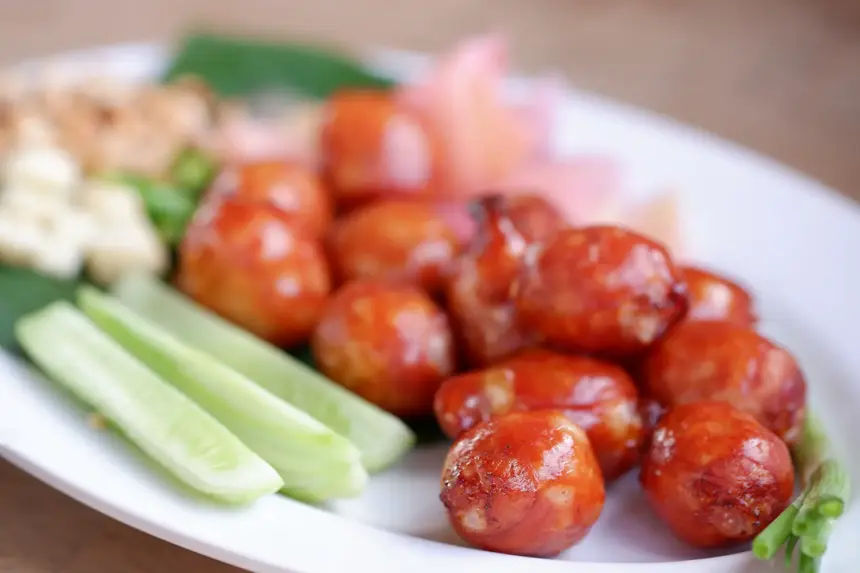Thai Food: Sai Krok Isan (Isan-Style Thai Sausage)
Sai Krok Isan, also known as Isan-style Thai sausage, is one of the most beloved traditional street foods in Thailand, particularly in the Isan region of northeastern Thailand. This distinctive sausage is known for its fermented, tangy flavor, a result of the fermentation process that occurs before cooking. Sai Krok Isan is typically made with pork, sticky rice, garlic, and seasonings, which are packed into casings and then left to ferment for a few days before being grilled or fried to crispy perfection.
In this article, we will dive into the history of Sai Krok Isan, its unique flavor profile, the traditional ingredients used in making it, and the process of preparing this iconic Thai street food dish. We’ll also explore its cultural significance in Thai cuisine and how it has gained popularity worldwide.
The Origins of Sai Krok Isan
Sai Krok Isan originated in the Isan region of Thailand, which is known for its bold, flavorful, and often spicy food. Isan cuisine is heavily influenced by Lao traditions, as the region borders Laos and has a shared history with it. The Isan region is also one of the poorest in Thailand, and as a result, its food is typically simple, using readily available ingredients like pork, rice, and herbs. However, the flavors of Isan cuisine are far from ordinary, and Sai Krok Isan is a perfect example of the region’s ingenuity in creating mouth-watering dishes with humble ingredients.
The use of fermentation in Sai Krok Isan is particularly interesting, as it adds a layer of complexity to the flavor of the sausage. In the days before refrigeration, fermentation was a natural way to preserve food, and it is still a common technique used in many traditional dishes throughout Thailand. The fermentation process gives Sai Krok Isan its characteristic tangy flavor, which sets it apart from other types of sausage.
The Unique Flavor Profile of Sai Krok Isan
One of the reasons Sai Krok Isan is so popular is because of its distinct and well-balanced flavor. It is a combination of savory, tangy, salty, and slightly sweet elements, with the added complexity of a fermented taste that deepens the overall flavor profile. When grilled or fried, the sausage also develops a beautiful crispy exterior, which contrasts with the tender and flavorful filling.
The tangy flavor of Sai Krok Isan comes from the fermentation of the sticky rice mixed with the pork. During fermentation, the rice ferments and produces lactic acid, which gives the sausage its signature sour taste. The garlic adds a pungent, slightly spicy kick, while the pork contributes a rich, savory flavor. This harmonious combination of flavors is what makes Sai Krok Isan so appealing, and it’s why it is often enjoyed as a snack, appetizer, or even part of a larger meal.
Key Ingredients in Sai Krok Isan
While the exact recipe for Sai Krok Isan can vary slightly depending on the region or personal preferences, the essential ingredients remain consistent. Let’s take a closer look at what goes into making this delicious sausage:
- Ground Pork: The base of Sai Krok Isan is ground pork, which provides the sausage with a rich, meaty flavor. In some recipes, a mixture of fatty and lean pork is used to ensure the sausage is juicy and flavorful.
- Sticky Rice: Sticky rice, or glutinous rice, is another crucial ingredient in Sai Krok Isan. It serves as both a filler and a fermenting agent. After being cooked and cooled, the sticky rice is mixed with the ground pork, allowing it to ferment over a period of time, which produces the tangy, sour flavor.
- Garlic: Fresh garlic is used generously in Sai Krok Isan, contributing a sharp, pungent flavor. Garlic also plays a role in the fermentation process, helping to enhance the sausage’s overall taste.
- Salt and Sugar: Salt is essential for both flavor and preservation, while a small amount of sugar helps balance the tangy and savory notes of the sausage. The sugar also aids in the fermentation process.
- Pepper: Ground white or black pepper is often added to the sausage mixture, giving it a mild heat and a bit of spice to complement the sourness of the fermented rice.
- Sausage Casings: Traditionally, natural casings made from pork intestines are used to encase the sausage mixture. These casings give the sausage a satisfying snap when grilled or fried. However, modern versions may also use synthetic casings.
The Process of Making Sai Krok Isan
While making Sai Krok Isan at home may seem intimidating, it’s actually quite a straightforward process. The key to success is patience, particularly during the fermentation stage. Here’s a step-by-step guide on how to make this traditional Thai sausage:
- Prepare the Sticky Rice: Cook the sticky rice by steaming it until it’s soft and fully cooked. Once cooked, let it cool to room temperature. The sticky rice will be mixed into the pork, aiding in the fermentation process.
- Mix the Sausage Filling: In a large bowl, combine the ground pork, cooled sticky rice, minced garlic, salt, sugar, and pepper. Mix thoroughly until all ingredients are well combined. This can be done by hand to ensure even distribution of the ingredients.
- Stuff the Sausages: Using a sausage stuffer or a funnel, fill the sausage casings with the pork mixture. Be careful not to overfill the casings, as the sausage may burst during cooking. Once filled, twist the sausages into smaller, individual links.
- Ferment the Sausages: Place the sausages in a cool, dry place and allow them to ferment for 1-3 days, depending on the desired level of sourness. The longer they ferment, the tangier they will become. It’s important to monitor the sausages during this time, ensuring they are not exposed to excessive heat or moisture.
- Cook the Sausages: After the fermentation period, the sausages can be grilled or fried until they are golden brown and crispy on the outside. The high heat will cook the pork through and crisp up the casings, giving the sausages a delicious texture.
- Serve and Enjoy: Sai Krok Isan is traditionally served with sticky rice, fresh vegetables like cucumber and cabbage, and fresh chilies. The fresh vegetables provide a refreshing contrast to the rich, savory sausage, while the chilies add a spicy kick.
Cultural Significance and Popularity
Sai Krok Isan is not just a delicious snack; it holds a special place in the hearts of the Thai people, particularly those from the Isan region. It’s a common street food in Thailand, where vendors can be found grilling the sausages over open flames, filling the air with the irresistible aroma of garlic and smoky meat. The sausages are often enjoyed on the go, skewered on a stick, or served as part of a larger meal with sticky rice and fresh herbs.
In Isan, Sai Krok Isan is also a dish that brings people together. It’s often made in large batches, with family members and friends gathering to help prepare and ferment the sausages. The communal nature of making and eating Sai Krok Isan reflects the importance of food in Thai culture, where meals are often shared and enjoyed in the company of others.
Sai Krok Isan’s Global Popularity
While Sai Krok Isan is a traditional Thai dish, its popularity has spread far beyond Thailand’s borders. As Thai food has gained international recognition, Sai Krok Isan has become a favorite among adventurous eaters looking to experience authentic Thai flavors. It’s commonly found in Thai restaurants around the world, and its bold, tangy flavor is a hit with both locals and tourists alike.
In recent years, there has been a growing interest in making Sai Krok Isan at home, with food bloggers and cooking enthusiasts sharing recipes and tips online. The rise of Thai street food markets in cities like New York, London, and Sydney has also contributed to the dish’s growing popularity.
Variations of Sai Krok Isan
While the traditional recipe for Sai Krok Isan remains the most popular, there are a few variations of the dish that have emerged over the years. For example, some versions of the sausage use different types of meat, such as beef or chicken, instead of pork. Other variations may include additional ingredients like lemongrass or kaffir lime leaves to give the sausage a more fragrant aroma.
In some regions, the fermentation process is shortened or skipped altogether, resulting in a milder sausage that lacks the characteristic tanginess of traditional Sai Krok Isan. These variations allow for a range of flavor profiles, catering to different tastes and preferences.
Conclusion
Sai Krok Isan is a true gem of Thai cuisine, offering a unique and flavorful eating experience that showcases the bold flavors of the Isan region. With its savory, tangy, and slightly sweet taste, this fermented sausage has become a beloved street food staple in Thailand and a popular dish around the world. Whether enjoyed on its own, as part of a larger meal, or paired with sticky rice and fresh vegetables, Sai Krok Isan is a must-try for anyone looking to explore the authentic flavors of Thai cuisine.
Making Sai Krok Isan at home may take some time and patience, but the end result is well worth the effort. With the right ingredients and techniques, you can enjoy the delicious taste of Isan-style Thai sausage no matter where you are in the world.










